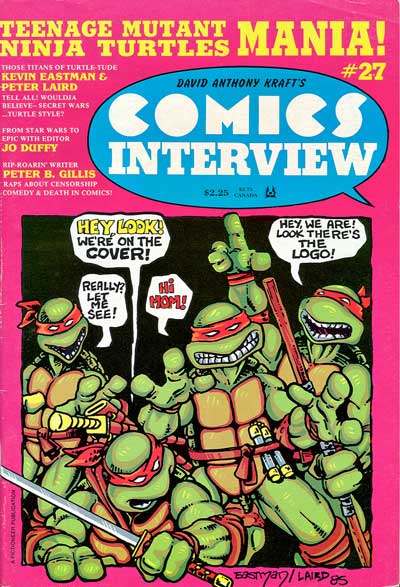
1985
I recall seeing an ad for the first issue of TEENAGE MUTANT NINJA TURTLES. The art and lettering were a perfect parody of RONIN, while the concept managed to satirize all the current trends in comics. However, I figured it was such a clever idea that it couldn’t possibly sustain a whole book. Worst of all, I didn’t snap it up when it appeared in the local comics shops. My mistake. In less than a year, the first printing of #1 has increased in value over 3,000%! Now in its fourth issue, the book continues to be a hot topic of conversation (and controversy) among fans, dealers, and speculators across the country. As the creators rested from a hectic day of being convention guests in Atlanta, we talked about their phenomenal success.
LAMAR WALDRON: You’re both basically artists, right?
KEVIN EASTMAN: Uh huh.
LAMAR: Okay, so who dies the writing?
PETER LAIRD: We both do.
KEVIN: It’s a split. A lot of people, that’s the first thing they say when the come up, “All right, you draw, right? And you write?” But we share the chores, almost fifty-fifty right down the line. We talk out the plot together, we sit down and talk about the idea, what we want to do with the book. Then I’ll do some small rough roughs, page layouts, and Peter and I will go over them together. Peter will pick out the ones that I gross him out with. He’ll say, “No, this is terrible,” or “This is good, keep this.”
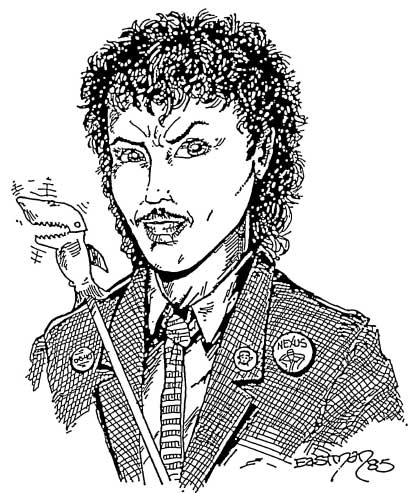 LEMAR: He picks out the ones you gross him out with – or he rejects those?
LEMAR: He picks out the ones you gross him out with – or he rejects those?
KEVIN: Oh, sometimes he pick the…
PETER: I mention them, and then we talk about them.
KEVIN: Basically, we’re very civilized.
LEMAR: Peter, do you just give Kevin feedback on his layouts, or do you do layouts, too?
PETER: Essentially, it’s worked out so that Kevin does the layouts for the book. Well, I did the first seventeen pages of the second book – but Kevin has done the layouts for everything else, including RAPHAEL, the one-shot micro-series.
KEVIN: Once we’ve agreed on everything, we both share the chores of actually enlarging the pages to their full size.
LAMAR: Do you use an opaque projection for that?
KEVIN: No, it’s all freehand. We redraw all the pages totally and we both share in the penciling activities. Then I do the lettering, although I’m afraid to admit it – I think my lettering’s terrible. Then Peter does all the finished scripting. He fine-tunes all the writing.
LAMAR: So, there’s no typed script, or anything like that? You basically work from the layouts?
KEVIN: Yeah. Peter finishes the writing. As for the inking, we do exactly fifty-fifty of that. If I start drawing a page, I’m only allowed to draw half of that, then Peter finishes the other half.
 PETER: Just so we have an even mixture of both of us.
PETER: Just so we have an even mixture of both of us.
LAMAR: Are you serious?
KEVIN: Totally.
LAMAR: I mean, – so every page…
PETER: Oh, no, it’s not that set in concrete. There are certain pages that Kevin’s inked totally and there are certain pages that I’ve inked totally.
LAMAR: But would it be safe to say that on every page in every book, each of you has made some contribution?
PETER: With one or two exceptions, yes. In most cases, it’s fifty-fifty.
KEVIN: It really is. We like to have a little bit of each of us on the page.
LAMAR: Did you have any precedent for this kind of partnership? Did this just evolve, or did you model this after some collaborative team that you were aware of, such as Frank Frazetta and Al Willimanson, or Stan Lee and Jack Kirby?
KEVIN: I think it evolved.
PETER: Yeah. Basically, we just started working together and knew we wanted to collaborate – it just seemed like this was the way to go. We’re each writers and artists, and we didn’t want any separation of effort.
LAMAR: What happens when one wants to do something that the other doesn’t like? How do you resolve disputes?
PETER: We argue about it – well, generally we discuss it first and then, if it gets to the point of arguing about it, we’ll argue.
KEVIN: It comes down to a compromise. I’ll give a little, then he’ll give a little. We work out something we both think is fair.
PETER: Here’s an example. On page nine in the first book, there’s a full-page city scent that Kevin drew. When we first did the book in pencil form and I saw it, I said, “Well, it’s a nice drawing, but I don’t think it fits. I think it slows down the action and I’d rather not have it in there.”
KEVIN: Of course, I felt it was essential for the storytelling because in the first part of the book they meet the Purple Dragons –
PETER: and there’s a long fight scent and this is afterwards –
KEVIN: – and I felt that this was necessary to break it up, to give the reader breathing space.
LAMAR: So you won. Why is that, because you’re taller?
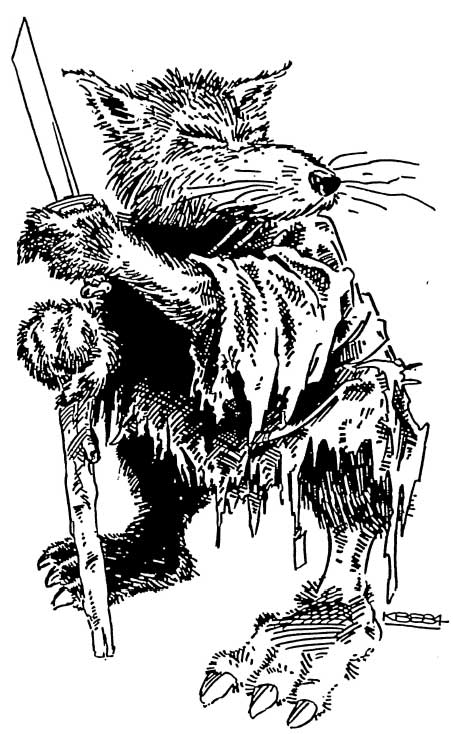 KEVIN: No, I had a lot of bigger friends who could rough him up and make threatening phone calls. (Laughter)
KEVIN: No, I had a lot of bigger friends who could rough him up and make threatening phone calls. (Laughter)
PETER: No. Essentially, Kevin was adamant. Eventually, I agreed – I wouldn’t say under duress, but a little reluctantly. But after it was all done, I said, “Hey, that’s great.” I love it now.
KEVIN: It was one of those things, you know, when you feel so strongly about it. It was an odd thing – I just felt that I had to have that page in there. That’s the only one we’ve had any real argument over.
LAMAR: I think it’s really interesting the way you guys work together. How did you come to meet each other? Is there any truth to the rumor that you were both raised by Gypsies and were separated at birth?
PETER: None whatsoever.
KEVIN: Peter was, but Mom never missed him. (Laughter.) She was glad we got rid of him, he ate too much cheese –
LAMAR: How long have you known each other?
PETER: Three years…?
KEVIN: Yeah, it’s been about three years since we met. Peter lived in Northampton, Massachusetts. He was working as a freelance artist there, and I was living in Amherst with my girlfriend, who was going to school there at the time.
LAMAR: You are from Massachusetts originally, then?
KEVIN: No, I’m originally from Maine.
LAMAR: Oh, Maine – I thought that was a Massachusetts accent.
KEVIN: Maine, too. After Massachusetts, it all gets the same. It only gets worse – more French, the closer you get to the Canadian border.
LAMAR: So you met three years ago…
KEVIN: It’s kind of a cute story, the way we met. I was working at a supermarket bagging groceries at the time. One night, I was riding home from work on the bus, bored to tears and saw this little magazine on the floor. It was called SCAT – it was some comics magazine. So, I picked it up and started thumbing through it. One of the more outstanding artisans in it was Peter Laird. I was so excited to find out that this book was printed in Northampton, which was the next town over. So I went over to the offices there and brought my stuff – I hadn’t published yet or anything – trying to get to do some work for them, and they said, “Geez, you draw a lot like this guy Peter Laird.” So they gave me his address and I wrote him a letter. He called me up a couple of days later. I went over and walked into this third-floor studio that he had. The first thing I saw was this original Jack Kirby art page and we hit it off from then on. We’ve been the best of friends since.
LAMAR: Going back farther that that – how did you guys come to be interested in comics in the first place?
PETER: I’ll take that. Well, I’ve always enjoyed reading. I’m a fairly voracious reader and I’ve always enjoyed artwork, and the combination of the two in comics has always been really appealing to me. So I’ve just read them, since I was a kid – especially since high school. Oh, yeah – Jack Kirby was a seminal influence on my drawing.
 LAMAR: What were your favorite comics when you were a kid?
LAMAR: What were your favorite comics when you were a kid?
PETER: You know, I can’t remember when I was a really young child, but when I was in high school it was the Kirby FANTASTIC FOUR, then when he switched over to DC, doing the NEW GODS, MR. MIRACLE, THE FOREVER PEOPLE, KAMANDI, THE DEMON, those things.
LAMAR: Kirby sounds like one of your big idols.
PETER: Yeah. And around the same time I also became aware of Barry Smith and his cutting loose with CONAN. That was something really different. I enjoyed that a lot.
LAMAR: And Kevin – how about you, for comics?
KEVIN: Comics when I was young? Besides the Kirby books – KAMANDI being my utmost favorite Kirby book at that time – I used to read a lot of the war comics –
LAMAR: Kubert?
KEVIN: Yeah, Kubert, very much so. I really enjoyed his stuff. It was more like the war comics than the superhero stuff at first.
LAMAR: You say you pretty much liked the Kirby, Smith, Kubert stuff – did these people have any influence on the work you’re doing right now? And if not, what are some of the influences, whether artists, writers, film makers, on what you’re trying to do on the TURTLES?
(Dead silence.)
PETER: Dead silence.
KEVIN: Dramatic pause.
PETER: I can’t say that there’s any really direct influence – I’m trying to think –
LAMAR: Well, did you ever go through the phase that Barry Smith did with Kirby when he did his Kirby imitation until he developed his own style?
PETER: Sort of, yeah. I was never as good a Kirby imitator as Smith was. I tried to take some of the essence of what Kirby was – I don’t know how successful I was, but… I can’t really say I imitated him. I tried to emulate him, maybe, but not imitate him so much.
LAMAR: Is there anyone else that has an influence on the work that you try to do, the way you tell a story?
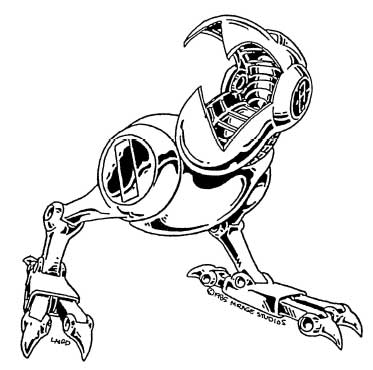 PETER: It’s really diverse and diffused, the influences that I’ve had. I can’t really specify one in particular.
PETER: It’s really diverse and diffused, the influences that I’ve had. I can’t really specify one in particular.
LAMAR: How about you, Kevin?
KEVIN: Me, personally? As far as influences, I’ve been very influenced by Rich Corben, Vaughn Bode, and Kirby. I was influenced by them in the way that they just had such a great, great way to tell a graphic story. They really strove so hard for the different angles, they tried so hard to make the story really interesting. That’s inspired me a lot to really try hard to do something different, just to try different things, to be really experimental – because, you know, the comics world has such a wide range of things that are being done that it’s fun to find a slot somewhere and really go crazy.
LAMAR: So you just want to be as loose as possible and try as many different –
KEVIN: Yeah, be really experimental. To have someone look at one of our books and say, “Gee, I haven’t seen that done in a while.” “I’ve never seen that done, ” or, “It’s something really different.” We really try hard to have a different product.
LAMAR: Did either of you guys go to art school, or have any kind of artistic training?
PETER: I went to the University of Massachusetts in Amherst.
LAMAR: Did you get a B.F.A.?
PETER: Yeah, a Bachelor of Fine Arts in printmaking.
LAMAR: Did you find it helpful at all in what you’re doing now?
PETER: Only in that I had to draw a lot more. Life drawing, stuff like that. I learned some techniques that have been helpful, but I should have gone to a more focused school for commercial art or design, because it was all fine art – and, while fine art is fine, it wasn’t really what I was interested in.
LAMAR: It gave you names for the characters in your comics.
PETER: This is true. Janson’s ART HISTORY.
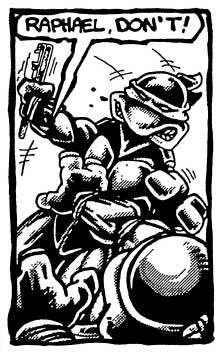 KEVIN: In junior high, early high school, my father used to draw a lot. We signed up together to take some life drawing classes, drawing models and stuff. I did go to art school for a whole semester at the Portland School of Art when I got out of high school. The Portland School of Art is a wonderful school and I really enjoyed it, but it wasn’t a state-funded school and it was really expensive. I was living on my own at the time and I just couldn’t afford it. So, basically, I just kept at it on the side. I still take life drawing classes when I can. I’m always learning all the time, but I’ve still got a long way to go.
KEVIN: In junior high, early high school, my father used to draw a lot. We signed up together to take some life drawing classes, drawing models and stuff. I did go to art school for a whole semester at the Portland School of Art when I got out of high school. The Portland School of Art is a wonderful school and I really enjoyed it, but it wasn’t a state-funded school and it was really expensive. I was living on my own at the time and I just couldn’t afford it. So, basically, I just kept at it on the side. I still take life drawing classes when I can. I’m always learning all the time, but I’ve still got a long way to go.
LAMAR: Who came up with the idea for the TURTLES? Who’s guilty?
KEVIN: Once again, it was like we do our plots, like we do everything – it couldn’t have come about if we didn’t feed off each other. It started one night when we were fooling around, working on a book called FUGITOID together –
LAMAR: FUGITOID?
KEVIN: Yeah. It’s about a robot. It’s going to be published later this year. But it was late, we were tired, and just kind of joking around, and I had this idea for this turtle character with this huge mask on and nunchucks strapped to his arms. It was just kind of bizarre. We giggled about it. Peter did his version of it and it went on and on. We got carried away and said, “Geez, why just one? Why don’t we do a group of four?” And so I did a sketch of the four Turtles together and I said, “Hey, this is great! We’ll call them Ninja Turtles!” – just joking – and Peter said, “No, why don’t we call them Teenage Mutant Ninja Turtles?” So it was really inspired by both of us.
LAMAR: Latter day Seigel and Shuster, eh?
PETER: Yeah. I hope we don’t end up like those two guys.
 LAMAR: Which brings us to the next point. How did you go about getting it from an idea stage to a published comic?
LAMAR: Which brings us to the next point. How did you go about getting it from an idea stage to a published comic?
PETER: Well, we did send out our FUGITOID story. We had done five-page segments which we were trying to sell as a backup story.
KEVIN: Yeah, we were just dying to get published, anything we could. We just wanted to draw comics so badly.
LAMAR: So you sent it to Marvel and DC?
PETER: No. All the alternatives. Pacific was still functioning at the time.
LAMAR: And nobody picked it up?
PETER: No. We got some nice rejection letters, but we were still burning with the desire to do a book, to get it published. We had this idea we were tossing around. We had worked out a whole story to explain how they are teenage mutants and ninjas and turtles, so we did it.
LAMAR: You mean you did the whole book without a publisher first?
PETER: Right. We decided by hook or by crook that we would see it in print. We had lots of discussions about how many we should print, because obviously it was going to be a self-published venture. We decided to borrow the money from Kevin’s Uncle Quentin –
KEVIN: And use all my income tax money.
PETER: His income tax money, and a little money that we had left over in the bank.
LAMAR: Had either of you ever published anything before?
PETER: I had self-published a few things. I did a calendar of the gods with my brother, which had a mythological deity for each month of the year. And I did a comic – a really crude one – a couple of years earlier.
LAMAR: So you had done a little self-publishing…
PETER: Yeah. We just had to get this book out. The other thing was that there was this local convention we had gone to, and there was going to be another one in four months, and we knew that we had to get something out to sell there, to premier, and whatnot. Se we did. We went ahead and found a local printer in Dover, New Hampshire, where we were living at the time, and we printed three thousand of them for us. Then, with some trepidation, we tried to sell them.
 LAMAR: What was the response initially, before it became a hot seller? Did you contact distributors like Bud Plant and Glenwood?
LAMAR: What was the response initially, before it became a hot seller? Did you contact distributors like Bud Plant and Glenwood?
KEVIN: Did we? No, I –
PETER: Yeah, we did actually, even before the book was printed. (To Kevin:) Remember, we did those press releases – the four-page ones with sample artwork? We sold about half the print run before the book actually came back from the printer to distributors – Bud Plant, and I think Glenwood picked up about a third of them, something like that, and then Capital bought some. When we got the books back from the printer, they were all sold.
LAMAR: The whole run?
PETER: Yeah, the whole run of three thousand. In fact, we sold all of them within a month. They were all out of the house. Then we had to do a second printing of six thousand.
LAMAR: Did the response surprise you?
KEVIN: Very, very much. We argued for the whole time we were drawing the book about just how many we should print. Peter’s like, “Let’s do five thousand!” and I’m like, “This is my money and I borrowed money from my family to do it. Let’s do a thousand and hope.” I figured that if we could sell five hundred books and make our money back, and just keep the rest to give to friends of whatever, then we were doing good.
LAMAR: Were you guys smart enough to keep back copies of the first printing of #1?
PETER: I wish we had been about fifty percent smarter, to tell you the truth. We didn’t hold back as many as we should. We were just so glad to sell them.
KEVIN: What is was, was the money didn’t really matter – just enough to break even. That we had finally published our own book, we were so tickled with that.
PETER: That we were even able to make our money back and break even was a real rush, because we fully expected to sell maybe five hundred of them and sit on the rest of them for the remaining time.
LAMAR: It’s probably the most successful self-published comic to come along in several years, since CEREBUS. What do you two think is responsible for the fantastic success?
 KEVIN: What do we think accounts for it? I’d love to say, “Oh, they love our artwork,” but a lot of people say it’s just the need for something different. They really enjoy it because it’s different. A lot of people come up and say, “I heard the name of this book and I had to have it.” The name is what brings the people to the book. Like I said before, what we want to shoot for is to keep it different, offbeat – something that will keep people coming back. I love my X-MEN, and I love my CRISIS ON INFINITE EARTHS, I like all those, but it’s nice to get away and maybe read the TURTLES, just for something different.
KEVIN: What do we think accounts for it? I’d love to say, “Oh, they love our artwork,” but a lot of people say it’s just the need for something different. They really enjoy it because it’s different. A lot of people come up and say, “I heard the name of this book and I had to have it.” The name is what brings the people to the book. Like I said before, what we want to shoot for is to keep it different, offbeat – something that will keep people coming back. I love my X-MEN, and I love my CRISIS ON INFINITE EARTHS, I like all those, but it’s nice to get away and maybe read the TURTLES, just for something different.
LAMAR: Do you think the reasons are pretty much the same, Peter?
PETER: I also think very strongly that the name is important, because so many people who don’t even read comics laugh when they hear the name. They chuckle, there are a lot of people for whom it does, and they go out and buy the book just to see what the hell it’s all about.
KEVIN: Usually, when you tell somebody the name of the book, it’s like, “What?!” It’s the first reaction. Like, “Yeah, we draw TEENAGE MUTANT NINJA TURTLES,” and ninety-nine times out of a hundred the answer is, “What?!”
LAMAR: The name does provoke a laugh. The contents, on the other hand, are played pretty seriously. Is it intended as a serious dramatic tragedy of modern turtles in a struggle for existence, or is it a little tongue-in-cheek?
(Long pause.)
KEVIN (to Peter): Umm… tongue-in-cheek to start?
PETER: Yeah… I mean, obviously the first issue was a parody of some very specific elements…
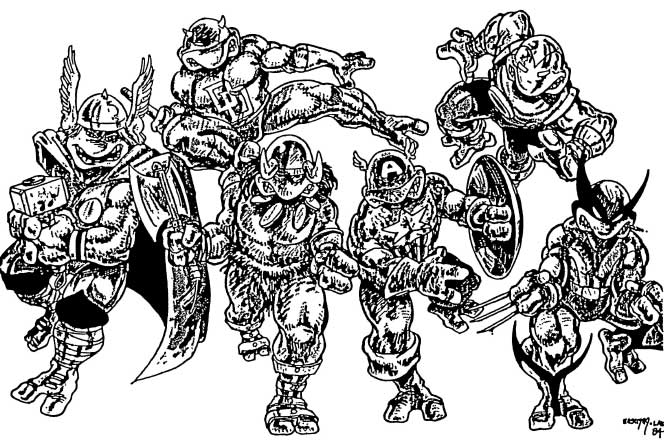 LAMAR: Like – ?
LAMAR: Like – ?
PETER: Oh, Frank Miller, RONIN…
KEVIN: The teenage mutants, then the ninja craze, and then the animal aspect of, oh, like CEREBUS, the crowd that CEREBUS draws.
LAMAR: Was there an intentional CEREBUS parody in there as well?
PETER: Only in the most oblique sense. It wasn’t direct at all.
KEVIN: No. Sim parodied CONAN and Barry Smith when he did his book, like we parodied Miller and his DAREDEVIL and RONIN when we did our book, and we were maybe hoping to achieve the same type of notice.
LAMAR: So it started out as a parody the first issue, and now you’re on your fourth issue. Is it still parody?
KEVIN: Definitely.
PETER: The parody elements in the book, as you notice, aren’t really strong. I mean, they’re not intense. I don’t know if you’ve read that Harvard Lampoon parody of THE LORD OF THE RINGS –
LAMAR: BORED OF THE RINGS?
PETER: Yeah. That’s like every sentence is dense with parody. I think that only works if you’re very, very clever. I personally don’t feel clever enough to maintain a consistently wonderful parody all the way through.
KEVIN: There were some parodies just in the style it was done in, like that DAREDEVIL thing in the origin. You know, where the person gets hit in the eyes with this radioactive ooze. That’s a parody. But the story is an original idea. We just want to keep getting more original.
 PETER: I like to feel that the humor is kind of incidental in the story. There are little flashes of it. The story is pretty straightforward. When you read it, you have to – well, I don’t know if you have to, but you should – no, I won’t even say you should – but you might chuckle at the fact that these protagonists are turtles, but they’re going through the motions of this very straightforward adventure story and, at least to my mind, there’s a certain amount of humor in that.
PETER: I like to feel that the humor is kind of incidental in the story. There are little flashes of it. The story is pretty straightforward. When you read it, you have to – well, I don’t know if you have to, but you should – no, I won’t even say you should – but you might chuckle at the fact that these protagonists are turtles, but they’re going through the motions of this very straightforward adventure story and, at least to my mind, there’s a certain amount of humor in that.
KEVIN: It’s underlying humor.
PETER: Yeah.
KEVIN: Hidden.
PETER: I think too many parodies aren’t successful because they’re so crammed with parody, so intense, like that BORED OF THE RINGS book. I’m not saying that it isn’t successful, but it’s heavy handed, just too much parody.
LAMAR: It also sounds like you’re moving somewhat in the same direction that Dave Sim took eventually. If you mention to most people today that CEREBUS started out as a parody of CONAN and Barry Smith, they’d say “What?!”
PETER: That’s true. The book will evolve. It already has since the first issue – you couldn’t say that #2 or #3 is a parody of anything really specific.
LAMAR: What are your future plans for the book.
PETER: Megasuccess. (Laughter.) No, just kidding.
LAMAR: “No?” You won’t take it if it’s thrust on you?
KEVIN: Naw. If it comes –
PETER: – total refusal.
….
KEVIN: Our plans for the future are to just keep enough people buying it so that we can keep drawing it.
PETER: And keep people entertained by it. If it ceases to be entertaining, it probably will cease to sell and we’ll have to go do something else.
KEVIN: We’ll have to go back to cooking.
PETER: Cookin’ lobsters and makin’ sandwiches.
LAMAR: Is it on a regular schedule at this point?
 PETER: Yes, there should be two more regular issues of the book this year. We have the FUGITOID book scheduled for mid-year – or, actually, September – and two microseries, one-issue series. The first was RAPHAEL, and then there’s going to be a special Christmas story featuring MICHAELANGELO.
PETER: Yes, there should be two more regular issues of the book this year. We have the FUGITOID book scheduled for mid-year – or, actually, September – and two microseries, one-issue series. The first was RAPHAEL, and then there’s going to be a special Christmas story featuring MICHAELANGELO.
KEVIN: It looks like we’ve got a book coming out every two months from now ’til the end of the year. The FUGITOID book, which comes out in August, is going to continue into issues #5 and #6 of the TURTLES.
LAMAR: Smart planning. Do you think we’ll ever see the TURTLES’ SECRET WARS? (Laughter.)
PETER: Funny you said that! Read issues #5 and #6!
KEVIN: Yeah!
PETER: No, really – there’s a certain element of similarity in those issues.
LAMAR: I guess that gives your readers something to look forward to in #5 and #6. How about you guys? Any future plans beyond the TURTLES and FUGITOID?
KEVIN: I want to do an issue of DAREDEVIL. Just to do something different, as long as it pertains to drawing. I’d love to try a mainstream book. I want to get a year or so under my belt so that I’ve got the experience to be as good, to do a nice one.
PETER: I think you’d do a great DAREDEVIL.
KEVIN: Yeah. Good splattering.
LAMAR: How about you, Peter? What are your goals?
PETER: I’m having fun with the TURTLES and I want to continue doing them, but I would like to continue what I was doing before the TURTLES. Not the things that I was doing commercially, drawing vegetables and boring stuff like that, but more fantastic things – in the realm of the fantastic. I would like to do a revival of Jack Kirby’s DEMON character, Etrigan.
LAMAR: By the way whose idea was all the Duo-tone board? That’s not seen much in comics any more.
PETER (to Kevin): It was your idea. You saw some of that stuff that I had and then you – wasn’t that it? You saw a couple of samples of it?
KEVIN: Yeah. I love the effect. We knew from the beginning that we would only be able to afford a black-and-white book and we wanted to do something that would make this black-and-white book look different from the others, something other than regular pen-and-ink, and the tones were a perfect outlet.
LAMAR: I thought you were Roy Crane fiends. The BUZ SAWYER approach.
KEVIN: That’s some beautiful stuff, it really is.
LAMAR: What are you up to circulation-wise on the combined printings for #1, #2, and #3?
KEVIN: Combined printings of the very first issue? Thirty-five –
PETER: First printing of #1 was three thousand, second printing of #1 was six thousand, and the third printing is going to be thirty-five thousand.
LAMAR: Thirty-five thousand?
KEVIN: Yeah. Get this – first printing of #3, we’re up to fifty-thousand books.
PETER: And #2’s first printing was fifteen thousand, the second was thirty thousand.
LAMAR: That’s pretty impressive. You’re outselling CEREBUS right now.
 PETER: I guess we are. The circulation of CEREBUS is twenty-something thousand. We’ve got forty-two thousand of the #3s sold already, pre publication. I have a feeling that in the coming months we’ll probably get some back orders for maybe another ten thousand. I’m not trying to brag, that’s just the way it seems to be working out. With the #2s we still have back orders. I hate talking casually about it, because this time last year we were just finishing inking the pages for this book – and in no way, shape, or form did we ever imagine that it would be this successful. It blows our minds.
PETER: I guess we are. The circulation of CEREBUS is twenty-something thousand. We’ve got forty-two thousand of the #3s sold already, pre publication. I have a feeling that in the coming months we’ll probably get some back orders for maybe another ten thousand. I’m not trying to brag, that’s just the way it seems to be working out. With the #2s we still have back orders. I hate talking casually about it, because this time last year we were just finishing inking the pages for this book – and in no way, shape, or form did we ever imagine that it would be this successful. It blows our minds.
KEVIN: For that matter, to have been paid to come down to Atlanta to do a convention was never even thought of as a possibility.
LAMAR: Hopefully, it will be the first of many for you. Have the TURTLES appeared in other countries yet? Europe, maybe?
PETER: Not published, but I did send a couple of the review copies of the first one after it was published to this Swedish fanzine GRAPHIC DREAMS and they did a review of it, a four-page review. They sent us a copy a couple of months ago of this big review in Swedish. We were even mentioned on the cover.
KEVIN: We got somebody to interpret it for us –
PETER: That was great. This guy who lived in Sharon, Connecticut, translated it.
LAMAR: And they said you were better than Ingmar Bergman, right?
PETER: Yeah, you must have read it. (Laughter.) Just kidding. It was neat, though.
LAMAR: Well, this seems to have exhausted all my copious notes here – is there anything else either of you would like to add?
KEVIN: TURTLES COME ALIVE IN ’85! That’s our motto for this year, thanks to Peter’s brother, Bruce.
PETER: My brother Bruce has to be one of the most devoted fans. He sends us a postcard almost every day. He does these little collages where he cuts pictures out of the book and makes Xeroxes of them and colors them in and sends them to us. Just to keep us going.
LAMAR: Sounds like a real devoted fan. When do they let him out of the asylum? (Laughter.) How old is he?
PETER: He’s thirty-four. It sounds a little stranger than it actually is.
KEVIN: He is our Number One fan. It’s very inspiring to have him behind us.
PETER: He thinks it’s neat and wants to encourage us.
LAMAR: Kevin, your Uncle Quentin, who provided some of the initial cash outlay for #1, must be delighted with the success of the TURTLES.
KEVIN: Yeah. He got his bucks back, but it was more important to him to see us get off the ground. When we asked to borrow money from him, he said, “I’ll give you the money. When you come up with a package, I’l like to see it. All I require is that you give me the money back that I gave you – ”
PETER: A no interest loan.
KEVIN: No interest. My uncle is a real nice guy. So we brought him over to the house and showed him what we had done, what we wanted to do. We had everything thought out, all the advertising, the book itself – we made up photocopies of it to show him what is was going to look like. He wrote us a check and said, “Go for it.”
….
